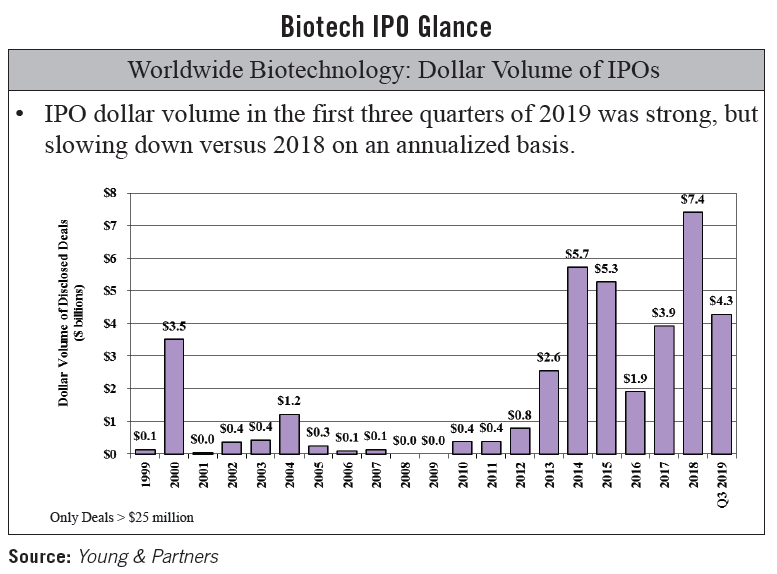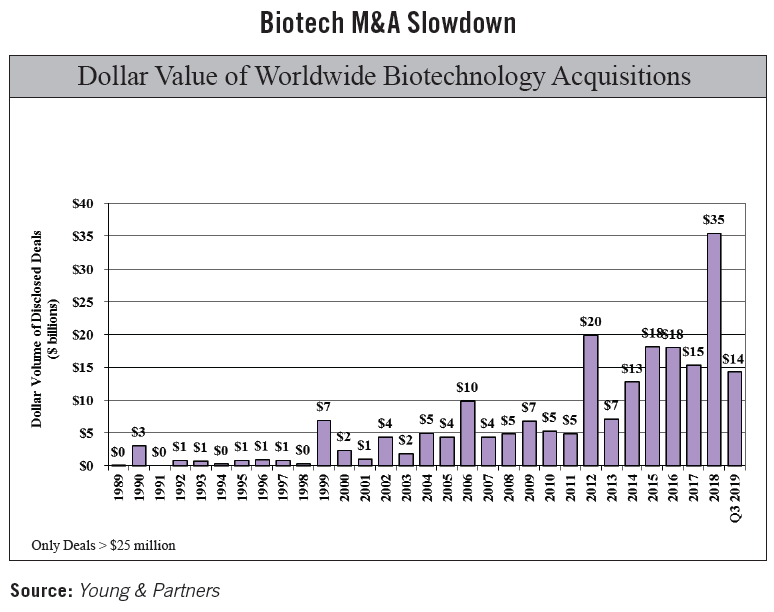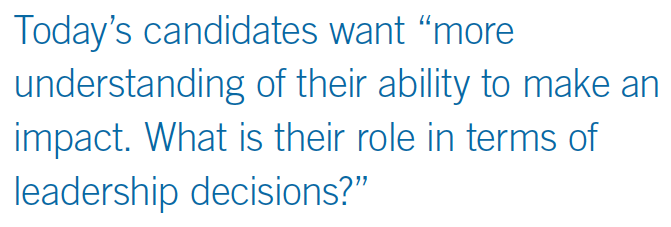Pharm Exec’s 2020 Industry Outlook
Pharmaceutical Executive
Pharm Exec’s annual forecast of the key issues facing biopharma leaders in the year ahead taps experts from several areas to uncover the seven new-decade trends to watch.

Pharm Exec’s annual forecast of the key issues facing biopharma leaders in the year ahead taps experts from several areas to uncover the seven new-decade trends to watch-from finance and policy to talent and technology, and more.
More Coverage:
Ecosystem of Growth
Why it’s important for biopharma to consider alternative ways to expand their business in an ever-changing landscape
“No man is an island,” John Donne wrote in 1624. Though society has changed much over the past four centuries, the quote remains relevant, especially when it comes to drug companies trying to grow their business. In the complicated landscape of pharma and biotechs looking for support in their drug development, the two entities are linked not just to each other but to the market at large. As a result, understanding market dynamics, preparing for the unexpected, figuring out where funding is available, and thinking outside the box have become necessary.
Balancing act
Since emerging in the mid-1980s, biotechs have become a major source of new drug development, bolstered by pharma’s weak productivity in R&D more recently. Though some biotechs might tackle regulatory, manufacturing, and sales functions, most still look to forge a relationship with pharma at some point to get their product to market. This might mean securing a partnership or licensing agreement, or getting acquired. Although partnering with a pharma company offers important business and financial benefits, a biotech might alternately look to the stock market (IPOs and secondary offerings) and venture capital firms for funding.
There is a strong relationship between M&As, IPOs, and funding. If the IPO market dries up and venture investments slow down, biotechs depend more on partnerships and exiting via a sale of the company. On the other hand, if the IPO market is robust and venture capitalists are investing generously, biotechs don’t have to look to pharma as aggressively.
Overall, the IPO market has been strong for many years. Young & Partners recently reported that during the first three quarters of 2019, 38 IPOs were completed worth $4.3 billion, compared with 50 IPOs worth $4.9 billion in the first three quarters of 2018 (see chart).
Click to enlarge

“We’ve also had a period where venture capitalists were very interested in biotech,” says Peter Young, CEO and president of Young & Partners, and Pharm Exec Editorial Advisory Board member. “That allows the biotechs to wait a little longer before they have to either sell or partner.”
The number of acquisitions also declined in 2019 for biotechs. After a modest surge in 2018, the volume dropped from $35 billion to $14 billion in the first three quarters of 2019, and there was only $5 billion in deals announced but not closed as of Sept. 30, 2019 (see chart below). The strength of partnering activity and access to venture and public equity funding contributed to this decline.
Acquisitions of pharma companies follow a different drumbeat as companies acquire for strategic, geographic, and revenue-preservation reasons. Young & Partners indicated that the number of M&A deals for pharma through the first three quarters of 2019 were lower than 2018. The volume of pharma deals, however, was much greater-$26 billion in 2018 vs. $80 billion for the same time period. This demonstrated a pickup after years of decline. However, $62 billion of the $80 billion was Takeda’s acquisition of Shire. This transaction may portend more mega deals, with Bristol-Myers Squibb’s acquisition of Celgene ($99.6 billion) and AbbVie’s purchase of Allergan ($86 billion) announced but not closed as of Sept. 30.
Click to enlarge

Another change in the biotech-pharma relationship that’s worth noting is the shift toward orphan drugs. These drugs require a much smaller salesforce and shorter approval process, and, therefore, much less funding, reducing a biotech’s need for pharma companies.
“[These elements are] a positive for the biotechs and a negative for the pharma companies, in relative power,” says Young. “But there are signs of some weakening in the IPO markets, which will tip the scales again. That will obviously have a negative impact on venture investing.”
Ready for anything
As these overlapping elements create an ever-changing environment, it’s best for companies to be prepared on many fronts when deciding how to grow.
“I think it’s impossible to just have one plan and stay with it because there are so many things you cannot control or predetermine what the outcomes will be,” says Young. “There’s no way to know [how long] the IPO market is going to be strong. You can’t have a plan that says, ‘Our only plan…is to do an IPO in two years,’ because that would be foolish.”
Young also says to beware of fads. “Everyone got really excited about CRISPR, and then there were safety issues and some negative press, and all of a sudden it went out-now maybe it’s coming back. Those are the things you can’t tell.”
Jigar Raythatha, CEO of Constellation Pharmaceuticals, learned the importance of having a plan B the hard way. In a Pharm Execpodcast, Raythatha explained how his biotech was blindsided when its one-and-only plan to partner fell through. After Genentech struck a deal with Constellation, it shifted its strategy and didn’t follow through on the acquisition.
“You can probably, in retrospect, call it a mistake,” says Raythatha. “[Constellation] had developed the company in a way to kind of hand over the rein. Unfortunately, lesson learned, the company didn’t have a plan B.” It took Constellation about a year to regroup and develop a new plan.
“It’s important to contingency plan and not necessarily to the same level of planning in each scenario, but thinking through what do you do if your key assumptions don’t pan out,” says Raythatha. “To have the ability to move into a new direction without having to completely reinvent the wheel, I think is quite important.”

Raythatha believes key stakeholders should be in alignment on major decision points. They should consider market shifts and discuss the company’s possible responses to those scenarios. Once that basis is established, the company should be adaptable to quickly flesh out a new plan of action, if needed.
Internal issues, such as toxicity, safety, or manufacturing problems, also can derail a plan. Millendo Therapeutics sustained two clinical setbacks that forced the company to adapt. (For details, listen to Pharm Exec podcast episode 46 here.)
“Ever since our first major corporate pivot, our overall goal is to have a pipeline of treatments in endocrine disease, such that if one drug failed, we didn’t have to start from scratch,” says Millendo co-founder and CEO Julia Owens.
When negative results emerged once again in a separate drug trial, Millendo was already in conversations with Alizé Pharma, and with the right team, money, and skills in place, Millendo was prepared to merge.
“We did two complex mergers and two financings in under 12 months,” says Owens. “That’s really hard to pull off. But we’ve always made sure we have plans B, C, and D in our back pocket in case we need them.”
Owens’ business development background has been helpful in navigating Millendo’s deals. For companies that lack such insight, hiring an alliance manager can add value. Lucinda Warren, vice president of business development, neuroscience, Janssen Business Development at Johnson & Johnson Innovation, spoke at the Association of Strategic Alliance Professionals’ European Alliance Summit this past November. She described an alliance manager as the “conductor of the orchestra.”
The position, whether in-house or outsourced, can provide big-picture oversight and targeted expertise in creating a plan, being proactive, and providing follow-through.
Outside the box
It’s important to include a mix of partnering pathways in a company’s master plan, not just traditional alliance routes. Sebastian Guth, president of pharmaceuticals in the Americas Region for Bayer, shares his long-term goals in a Pharm Execexecutive profile. Though partnering with academic institutions and collaborating with biotechs might sound typical, Guth’s overall vision is driven by innovation, evident in Leaps by Bayer, a division that invests in breakthrough ideas.
“We are at an inflection point where breakthrough science is transforming care almost daily,” says Guth. “Bayer had to make a clear choice between pushing the boundaries of science, investing in the big bets, or staying in the here and now. And we’ve made our choice and are convinced that science and innovation are the way to go. In many ways, the decisions that we have made are already being reflected in our portfolio and pipeline today.”
With an open-minded outlook such as this and keeping a pulse on the everchanging ecosystem in which biotech and pharma exist, companies can forge ahead with confidence to grow their business.
- Elaine Quilici
For another look at biotech runway/financial options read a recent executive Q&A here.
Is Oncology R&D Sustainable?
As spending and costs soar, breakthrough promise remains
While oncology drug pipeline activity and innovation have been consistently on the radar for a number of years, could the field be bordering on saturation? Let’s consider these numbers from the IQVIA Institute for Human Data Science’s Global Oncology Trends 2019 report.
- There are more than 700 life sciences companies with cancer drugs in late-stage clinical development and 463 of these are emerging biopharmaceutical organizations.
- Of the 33 large pharma companies with global pharmaceutical sales over $5 billion in 2018, 28 have large and active oncology pipelines.
- Biomarkers that stratify patients likely to respond to therapy are now included in 39% of oncology trials, up from 25% in 2010.
- The pipeline of drugs in late-stage development expanded 19% in 2018, mostly due to a large increase in the number of targeted biologics, which now represent just over 90% of the total oncology pipeline for the first time.
- There are 98 next-generation biotherapeutics-defined as cell, gene, and nucleotide therapies–in the midst of clinical investigation in cancer. These pipeline products leverage 18 different treatment approaches.
Success dip
On the clinical trial side of the oncology pipeline, the number of trials initiated in 2018 increased 27% over the prior year, to 1,170, and is up 68% over the past five years. But the composite success rate of oncology trials fell from 11.7% in 2017 to 8% in 2018. Clinical trial duration is also highest in cancer, but it has declined over the past five years in each phase.
For more on how industry is advancing clinical trial designs, such as basket trials and adaptive trials, watch this recent webcast from Applied Clincial Trials.
Once commercialized, as noted earlier, the majority of companies with over $5 billion in sales in 2018 have large and active oncology pipelines. And spending on all medicines used in treating cancer patients reached nearly $150 billion in 2018, up 12.9%, marking the fifth consecutive year of double-digit growth. New oncology brands in the US include some therapies with prices above $100,000 per year.
The median annual cost for new brand launches in 2018 was approximately $148,800, a drop from $162,150 in 2017. To date, however, payers continue to cover oncology therapies. Total spending on cancer-targeted treatments was up 17.5% in 2019 (12 months ending June 30, 2019), reaching $135 billion.
Policy and pricing
While many policies are being floated to address high drug costs overall, (see Editor’s Note), Murray Aitken, executive director of the IQVIA Institute, stated at the recent Pharm Exec Editorial Advisory Board meeting, “We shouldn’t be single-mindedly focused on looking for policy changes to impact the pricing environment. We do have competitive market dynamics that will have at least as much impact, especially when so many companies are heavily invested in succeeding in oncology.”

Aitken elaborated that while the spending pie continues to increase, the pace likely won’t be fast enough for all companies’ products to provide an economic return on investment. “It’s a perfect storm of surging innovation, [with] the rest of the healthcare systems struggling to keep up,” he said. “Every large pharma company over-invested [in oncology], hundreds of emerging biopharma with VC funding and so on, pursuing this area.”
Time will tell. As noted in this Bloombergarticle, many large pharmas have re-engineered their pipelines through acquisition to bolster their oncology offerings. Others, like Novo Nordisk, have made the choice not to invest because of the reasons stated earlier.
- Lisa Henderson
Tuning into Talent in 2020
Recruiting and cultivating the new breed of pharma leader
As the pharma industry evolves and fractures into a new landscape of healthcare giants and specialist operators, the “war for talent” continues to exert pressure on hiring processes. To attract and retain a new breed of pharma leader, more flexible recruitment strategies and retention policies are now the order of the day. As posited by the “Transformation and Talent Strategies” session at the FT Global Pharmaceutical and Biotechnology Conference in London, in November, pharma companies’ success “will depend on their ability to attract, develop, and retain high-performance talent from across a wide range of industries, develop new operational and organizational models, and break down the silos inhibiting innovation.”
Among the challenges raised at the FT conference, the transition of leadership talent from pharma to biotech was one that resonated with the executive recruitment experts that spoke to Pharm Exec recently. Chris Smith, director at Hays Life Sciences, says that in the last few months he’s seen more specialist biotechs “entering a phase of scientific recruitment and building out beyond their core talent than in previous years,” and that this “proliferation of innovators is grabbing talent at a pace.”
Rebecca H. New, managing director and head of RSR Partners’ Human Capital and Healthcare & Life Sciences Practices, told Pharm Exec that within startup companies, “venture capitalists are acting more like private equity holders-investing in and helping owners keep the drugs longer.” As such, “they need commercial business leaders-people who don’t just know how to sell, but who also understand market dynamics, the supply chain, how to launch drugs, etc.,” she says.
With many companies building their own factories to avoid long lead times with third-party manufacturers, New adds, “there’s a need for people to run them-specifically, people with knowledge of how to drive and ensure quality, containment, engineering, and manufacturing production knowledge.”
Such skills “are in high demand and short supply,” New says. However, as startups and growing small and mid-size enterprises are more “nimble and agile” than large pharma companies, they can have the edge when it comes to securing these skills, according to Smith. “Smaller companies can be leaner in their processes and quicker in their actions, and their internal equity conversations can be a little bit easier,” he says. Not least, “they can offer the potential for quick grosses and share options and potentially lucrative payouts.”
Motivating millennials
Whether a small startup or a large multinational, pharma companies need to tailor their offerings to a new generation of employee, namely, the millennial. The FT talent session highlighted the importance of creating “a value proposition that will attract millennials.” New says that “in many ways, millennials are voicing what all of us have probably wanted, which is to feel engaged, to feel a part of something bigger.” She adds that they are more assertive about things like work-life balance than previous generations, and as a result, “companies are starting to think differently around their compensation models and labor pools. They’re offering more

flexibility, for example, for individuals who may want to be part-time or part of a consulting team instead of a full-time employee.”
Millennial attitudes are also diminishing the need for relocation. Smith notes that while top-level executives have long been given scope to travel, there is now more of a demand for remote working at the mid-tier and senior management level. Companies are becoming more amenable to this “when trying to attract people with very specific skill sets.”
Moreover, today’s candidates want “more understanding of their ability to make an impact,” adds New. “What is their role in terms of leadership decisions? What’s their accountability?” she says. “Whether they’re in business-unit leader or COO roles, one thing I see is more and more individuals wanting to have a greater involvement in the product side. Not in terms of the development of the products, but in being able to help shape insights around utilization and customer analytics to help define other applications.”
Dealing with diversity
While diversity and inclusion are key concerns across most modern industries, pharma still has some way to go to compete with those at the more progressive end of the scale. “I haven’t seen anything particularly shift over the last 10 to 13 years,” Smith told Pharm Exec. “Bear in mind, however, the types of people we’re placing. At the senior director or VP level, diversity isn’t normally part of the brief.” He adds, though, that, in his experience, the industry “has always been reasonably diverse. It’s not quite as dominated by middle-aged white men as, say, the tech industry.”
New sees biopharma companies under more pressure-from analysts and sometimes from consumers-because “their leadership should match their customer base.” But there remains a challenge, she says, “in that most companies are continuing to look for talent within their own industry, trying to find the ‘traditional’ CEO and CFO. This narrows the search pool, and, in some cases, makes it near impossible to find diversity, by any definition.”
The IT function is one area where companies are looking for talent outside of the industry, thus fostering more opportunity for diversity, agrees New. “There is a great demand for candidates in project leadership, programming, and coding,” she says. And in large-molecule companies, for some positions such as finance “there is more receptivity to looking at individuals who may have worked in other regulated industries.”
But if we extend the definition of diversity to “breadth of talent,” then companies “have to embrace that talent earlier if they really want diversity,” says New. She explains: “Potential leaders should be encouraged to rotate on a regular basis through functions such as M&A, Global, P&L, and Operations early in their careers. This will help if or when they return to their function, as they will be able to talk the language of the C-suite and make more informed business trade-off decisions.” She adds, “It’s not about mentoring, it’s about enabling talent, so that when it’s time to fill a position, there is some choice.”
- Julian Upton
AI’s March Grows Louder
The potential of smart voice technology in pharma
According to projections cited in The Atlantic, by 2021, there will be nearly as many voice-activated smart speakers in the world as there are people. Additional reports1,2 find that this year, at least 50% of online searches will be voice searches and that smart speakers will overtake tablets in sales and use by next year.
But, in practical application, what do these trends-and the broader growth of AI-powered technology-mean in the realm of healthcare and patient engagement?
“Voice is one of those areas that’s going to have a huge impact,” says Bryan O’Malley, head of digital at Fingerpaint, a healthcare marketing agency. “We already see this with the prevalence of Alexa in people’s homes and the way they use Siri on their phones. I don’t think anyone has really set the trend yet for how [healthcare and pharmaceutical] marketing is going to be done through voice assistants, so there’s still a lot of blue sky to work with on how to best approach it.”
O’Malley does, however, see inroads being made in the pharma space that could point the path forward, as marketing strategies are attempted with the goal to “settle into where consumers are really comfortable.”
To that end, Amazon, for instance, has a smart voice tool that’s not just helpful from an informative standpoint, but is also e-commerce enabled, a feature that has extended into the medicine commercial and
Bryan O'Malley

purchasing market. “You can, for example, say, ‘Hey Alexa, add something to my shopping cart.’ So, we’re starting to see some advertisements for over-the-counter products that are including that capability,” explains O’Malley. “Domino’s [Pizza] already did something like that in the non-pharma space in a Super Bowl ad a few years ago. I think that the less-regulation parts of our industry like OTC are going to really dive into that because of the prevalence of these devices.”
As far as investment decisions around these technologies for treatment brand teams and consultants, Amazon and Apple are clearly dominating market share. “Those companies are also putting healthcare as a focal point for a lot of their initiatives,” says O’Malley, pointing to a recent partnership Amazon established with supermarket and pharmacy chain Giant Eagle, where customers with an active prescription can refill their medications right from Alexa and be reminded when to take their drugs.3 “If you have a prescription for a migraine medication, for example, you can just yell out, ‘Hey Alexa, refill my prescription,’ and it will contact the pharmacy, work out all the arrangements, make sure refills are available, etc.”
Simplifying this process further, O’Malley believes it’s not a far stretch in the future for patients to be reminded by their smart speaker to ask about refills every 30, 60, or 90 days-and fulfilling a prescription with a simple “Yes, Alexa.”
Beyond these platform advances on the high-tech side, there is the underlying question for healthcare marketers of what can they do to help advance the brand and, as O’Malley emphasizes, “meet the audience where they’re already at.” Several companies are already involved in short message service (SMS) efforts to enable patients, for example, to access their copay cards through digital devices. Smart speakers could potentially orchestrate and arrange that same access, to go along with providing product details and answering patient questions.
“Similar to the way that you might get your airline tickets in your own digital wallet, you might use a voice assistant to add a copay card to that wallet as well. It’s about tying existing initiatives with a brand into the voice ecosystem,” says O’Malley.
The adherence advantage
Patient care companies are experimenting with AI and voice recognition tools to improve patient adherence and compliance. San Francisco-based Catalia Health, for example, has a system for individuals with chronic disease to help manage ongoing treatment. Using a voice-based interface, its AI-powered robot, Mabu, enables healthcare providers and pharma companies to better support patients. The cloud-based platform can hold unique conversations with patients and try to intelligently respond to queries. Mabu will ask things like, “How are you feeling today? Did you take your medication?”
“It’s about trying to engage the patient throughout the course of their treatment and sharing that information back with their physician, so they can track how they’re doing,” says O’Malley.

These technologies, he notes, could become increasingly popular with seniors, children, and other patients who might be looking for emotional support during treatment. “We see this in Japan where they’re very technologically adept, and really build technology into their culture,” says O’Malley. “They love things like robotics and animations and are continuing to push for robotics at home for that emotional support.”
Weaving technological advances in video and augmented reality with existing smart voice innovation begs the question of how far telemedicine can go. There’s increasing capability today where patients can video chat with a doctor to describe symptoms and have treatments prescribed without setting foot inside an office. With regulatory, compliance, and data collection issues still to figure out, the advent of intelligent voice technology in healthcare, nevertheless, looks poised to catapult this dynamic to new levels in the near future.
-Miranda Schmalfuhs
References
1. https://www.dbswebsite.com/blog/trends-in-voice-search/
3. https://www.cnbc.com/2019/11/26/amazon-alexa-will-now-remind-you-when-to-take-your-pills.html
Cell & Gene Cascade Continues
Attention shifting to areas beyond pricing and reimbursement
Pharm Exec’s 2019 Industry Trends report included “Gene therapies change pricing and payment model dynamics,” which outlined exactly what it says-the scope of pricing, value, and accompanying payment models for the changing therapeutic landscape. This year, the topic has evolved to everything that follows once that cell or gene therapy is priced and available-manufacturing scale-up, patient and hub services, physician education/awareness, and impacts to sales force changes.
We tackled the manufacturing problem a bit in a November article, where Salim Syed, head of biotechnology research, senior biotechnology analyst, and managing director at Mizuho, noted that manufacturing in the small-molecule world was a different story. “Now it matters how good you are at manufacturing,” he said. “And as these therapies get more complex, it matters even more.”
As our sister publication Pharmaceutical Technology notes in this article, large-scale viral vector manufacturing lacks automation in key steps of the process, has immature supply chains, a lack of standardization of raw materials, and is just a start for the current state of manufacturing in this area.
In the November Pharm Exec article, we noted that many pre-commercial and commercial companies are opting to create their own manufacturing sites. BioMarin, AskBio, Wave Life Sciences, and bluebird bio were among those doing so, the report noted. Since its publishing, more companies are signing on for manufacturing prowess in cell and gene therapies. Novartis set aside $500 million to scale up its gene therapy manufacturing efforts; and Astellas purchased Audentes for $3 billion, adding the latter’s pipeline of gene therapies, as well as its large-scale cGMP in-house manufacturing capabilities.
Meanwhile, contract development and manufacturing organizations (CDMOs) are also hoping to get a piece of the pie. One example is Thermo Fisher Scientific’s recent opening of a $90 million, 50,000-square-foot viral vector manufacturing facility in suburban Boston. Earlier last year, Thermo acquired viral vector CDMO Brammer Bio.
Murray Aitken, executive director, IQVIA Institute and member of the Pharm Exec Editorial Advisory Board (EAB), said at a recent meeting of the Board, “The whole infrastructure for handling these novel therapies is still a big barrier, and it’s going to take a few years before the infrastructure and platforms are established for these therapies to become commonplace.”
“The patient engagement model is completely changing right now,” added EAB member Nicole Hebbert, SVP, head of patient support services at UBC, during the meeting. “What hubs looked like 10 years ago, or even five years

ago, is not the same pertaining to the set of services you have to wrap around the patient in regard to gene therapy. Before, we were talking to a specialty pharmacy to make sure patients received their medication. But, now upstream, there is so much more to do to engage. You are literally side-by-side with manufacturing and production management to track and facilitate access across the supply chain.”
The links connecting the therapy, patient, caregivers, and often teams of physicians is another factor driving the gene and cell therapy cascade. Historically, field sales professionals were tasked with physician detailing and product education about approved therapies; now they have a lot more information to share. Says Hebbert: “Detailing that [physician] practice now takes more time to also cover the complex delivery methods that have to happen to support a gene or cell therapy.”
A report published in the December issue of Pharm Exec, authored by Meghan Oates-Zalesky, senior vice president of marketing at InCrowd, found a significant gap in physicians’ understanding of nucleic acid-based therapies, which includes RNAi, siRNA, ASO, mRNA, AAV, CRISPR, and TALENs. An InCrowd survey found that oncologists had the most familiarity with these therapies, but 20% of primary care physicians (PCPs) and 15% of pediatricians did not. Further, physicians in academic vs. non-academic practices reported familiarity with gene-based therapies, at 34% vs. 24%, respectively.
Oates-Zalesky noted: “The findings suggest biotechs and pharmaceutical firms face an opportunity for physician outreach and education on gene-based therapy fundamentals, as well as initiatives that build awareness of approved therapies and progress of others through the pipeline.”
Pharm Exec will continue to monitor this dynamic area for changes and updates for our readers.
- Lisa Henderson
Data’s High-Tech Disruption
Influx of new players challenges healthcare data ownership question
The entrance of high-technology giants into the world of healthcare data collection-while offering promising advances for population health, disease prevention and management, and precision medicine-has further fanned the already volatile climate around data protection and quality, and, ultimately, patient trust.
Perhaps the most notable example was November’s public revelation that Google had launched “Project Nightingale,” a partnership with Catholic health system Ascension that gives Google’s cloud analytics access to millions of patient medical records in 21 US states, with the purpose of culling information to provide advice on improving care and enabling more targeted delivery. The announcement triggered a federal inquiry by the US Department of Health and Human Services Office for Civil Rights over whether the project complied with HIPAA privacy laws. Other big-tech stalwarts, including Amazon, Apple, and Microsoft, have jumped into the healthcare data fray as well, either through introducing AI and machine learning tools or launching their own dedicated healthcare ventures (i.e., the Amazon, Berkshire Hathaway, and JPMorgan deal). New startups, including digital biomarkers and digital therapeutics (software as a medicine) companies; retailers; payers; and even pharma are also vying for their own piece of the pie in the complex digital product market.
Competing forces
Nevertheless, despite these best intentions (and similar efforts by the NIH and others in collecting genetic and health data to accelerate medical breakthroughs), they are all, in essence, competing for patients’, or consumers’, loyalty and data. Most recognize that direct relationships in healthcare are no longer patient-physician dominated, but it’s in the collection and use, in some cases, of private medical data that continues to raise scrutiny from patients, lawmakers, and others. How robust are the algorithms employed to analyze the data? Is there evidence that shows alignment with data quality and integrity standards? And then there are operational considerations for the broader ecosystem. In the medical field, though new data privacy and sharing laws have been enacted by individual states in the US, for instance, and, globally, with recent legislation updates in the European Union, the lack of evolving compliance frameworks to keep pace with AI, big data, etc., remains a hinderance.
“We’ve clearly been reputationally challenged,” said Eddie Martucci, CEO, Akili Interactive, a digital therapeutics company, during the recent FT Global Pharmaceutical and Biotechnology Conference, citing the Facebook-Cambridge Analytica data scandal as an example. “It’s because we’ve used this data exhaust, this data by-product to try to monetize in different ways. When data is the central point-that changes the dynamic. The companies that will win are not those that have the very best product on day one. It’s who can most quickly respond to patient data [issues], respond to patient needs.”
Owning up
Valuing the patient experience, and building trust, experts say, can help add context to the not-always-easy question of who owns the data. The simple answer, most agree, is the patient, with many, even drugmakers themselves, arguing that, for instance with research, individual data from clinical trials should be returned to the participants, “because it’s about the autonomy, not just the ownership,” said Dr. Jessica Scott, head of R&D patient engagement, Takeda.
The data-driven relationship itself, however, should be owned by all stakeholders, experts contend, and be treated as a partnership, with the focus on providing immediate value to patients. That could involve, for example, patients potentially controlling their data and voicing their perspectives in clinical trials; or biomarker screenings and the chance for patients to see how their results may help improve diagnosis and drive innovation for diseases like Alzheimer’s; or payers considering patient satisfaction measures in reimbursement and formulary decisions.
“We can’t forget there is no such thing as the ‘average’ patient,” says Hanno Ronte, partner, Monitor Deloitte. “There will always be people who have different answers. Digital and data have the ability to be much more precise, to the unit of one, but scarcely predictive of the average. We as individual patients have an obligation to interact with our data and with our healthcare system in a way that actually makes our voices heard and makes the data useful.”
- Michael Christel
Beyond BRIC, Into MIST
Setting sights on pharma’s next-tier terrain
Although the BRIC countries (Brazil, Russia, India, China) or BRICS (if we add South Africa) tend to dominate discussions of “emerging” pharma markets, it is useful to cast an eye over “MIST,” another catchy acronym coined by economist Jim O’Neill that comprises Mexico, Indonesia, South Korea, and Turkey. In terms of their pharma markets, Attieh and Tannoury noted in 2017 that sales in both BRICS and MIST countries had doubled in five years, reaching a market share of approximately 20%,1 while McKinsey & Company, choosing to group Mexico and Turkey with BRIC, observed that these “BRIC-MT countries” would be instrumental in driving an expected USD$190 billion of pharma sales growth between 2015 and 2020.2
Given the volatile political and economic factors affecting some emerging market countries, however, the question of whether BRIC or MIST remain useful as pharma-market groupings is worth considering as we move into 2020 and beyond.
Mexico
For Rachel Howard, director at global healthcare market research and consulting agency Research Partnership, Mexico is “perhaps the most challenging of the four markets to predict what will be happening 12 months from now.” Much of this uncertainty is down to the “wild ride” of changes to the healthcare system that have

characterized the first year of President Andrés Manuel López Obrador (commonly referred to as AMLO)’s six-year term, following his election in December 2018. AMLO’s plans to disband Seguro Popular, the health administration system set up in 2003 to provide access to healthcare for the uninsured population, and create a unified, nationalized health service “has not proven easy to achieve,” says Howard, not least because of strong resistance from the unions. Instead, AMLO founded INSABI (the Institute of Health for Welfare) to replace Seguro Popular and absorb state-run systems, covering over 60 million citizens. However, “the finances to run this system are severely lacking, meaning there is huge pressure to contain costs.”
Rachel Howard

Moreover, notes Howard, the AMLO government has empowered an office of the Ministry of Finance to get involved in the procurement of pharmaceuticals for all of the state institutions in an attempt to constrain expenditure. But “tender conditions are aggressive and unfavorable to manufacturers, leading to instances of suppliers withdrawing from the market,” she told Pharm Exec. The government has also recently circumvented the Mexican regulatory body, COFEPRIS, to purchase unregistered drugs from overseas, leaving COFEPRIS’s future uncertain and the pathway to market access in Mexico “increasingly less transparent.”
At the same time, says Howard, Mexico’s private sector has “enjoyed a healthier trajectory, benefiting from a significant rise in the number US medical tourists seeking treatment across the border.”
Indonesia
Indonesia’s Healthcare and Social Security Agency (BPJS), launched in 2014 to administer a universal healthcare program (JKN) across the country, continues to struggle, says Howard. The system now covers 30%–40% of the Indonesian population but is running at a deficit exceeding USD$1 billion. From January

2020, the government will double participants’ monthly premiums in an attempt to overcome the shortfall. However, fearing the scheme’s slow repayment process, many private hospitals have resisted joining the program, and “those providers that have joined have shifted their focus to cost control rather than quality-meaning that biopharma sales growth has stalled in recent years,” explains Howard.
She adds: “Although Indonesia has opened up to allow foreign private healthcare providers to establish themselves in the market, the country’s infrastructure is not yet sufficiently developed to accommodate medical tourists. Rich Indonesians instead tend to travel to other Asia-Pacific destinations in search of quality healthcare.” The number of private hospitals is growing but they are still concentrated on the islands of Java and Sumatra, with areas outside of the main islands remaining underserved.
South Korea
South Korea’s place within the MIST grouping is contentious as it is “by far the most advanced of the markets” and, “arguably not ‘emerging’ at all,” says Howard. South Korea was the first country in Asia to consider pharmacoeconomics data, have a well-established and transparent health technology assessment program for

pharmaceuticals and medical devices, and the country already enjoys a thriving medical tourism market. “With South Korea pushing to position itself as one of the world’s leading medical hubs, we expect to see continued year-on-year growth through 2020,” observes Howard. “The government is actively investing in biopharma innovation and is making rapid progress with the consolidation of hospital medical data into a form that seamlessly supports digital health initiatives. We can expect state-of-the-art techniques to become increasingly commonplace as the country pioneers the latest technologies in healthcare.”
Turkey
“Turkey has long been considered a challenging market for innovative pharma due to its aggressive implementation of external price referencing, which means prices tend to be the lowest in Europe,” says Howard. In addition, she notes, the country’s volatile exchange rate has been a source of uncertainty for

international players. Economic recovery could be faster than expected, however, and “Turkey has growth potential, with its universal healthcare system now well established through the Health Transformation Program.” The proportion of GDP allocated to healthcare remains low at 5% and the current pricing environment is restricting access to innovation, but there are “positive signs of progress,” adds Howard. “The Turkish government’s ambitious ‘Vision 2023,’ announced back in 2013, sets out improving healthcare as a priority area, with goals of increasing the number of physicians per 100,000 people, stimulating the domestic biopharma industry, and establishing the country as a medical tourism hotspot.”
MIST or MINT?
Given South Korea’s advancement compared with the rest of MIST, some analysts think Nigeria fits more comfortably in the group, hence another O’Neill acronym, “MINT.” While Nigeria is the smallest of the MINT economies, it was two years ago the fastest growing. But a long list of factors continues to make Nigeria problematic from a pharma perspective. It is dogged by the lack of standardization of many drugs of herbal origin; the government’s inability (or unwillingness) to deal with the illegal importation, manufacture, and sale of fake medicines; and poor research support from the government and private companies.3 The scale of Nigeria’s infrastructural, political, and fiscal challenges means that its potential will take longer to realize than in other MINT markets, says Howard.
Emerging from ‘emerging’
If South Korea is rising above MIST, China looks to be breaking out of BRIC. Howard has seen the China market “hugely opening up” in 2019, where Brazil has continued to be dogged by political questions, India still has challenges with patent protection, and Russia has “dropped off the radar a bit.” The 2019 agenda was “overwhelmingly dominated by biopharma wanting to keep up with China,” says Howard. “It is now the number-one must-win. And as global pharma still has a lot to learn about how to win in China, it will continue to be a big area of concern in 2020.”
China and South Korea underline the arguably increasing redundancy of the term “emerging markets.” But if the term fails to accurately reflect the diversity of the countries or their varying levels of advancement, it at least remains, says Howard, “good shorthand for the markets outside the US, Europe, and Japan.” As we enter a new decade, however, it will be interesting to see how the changing pharma fortunes of BRICS and MIST-as well as those of Colombia, Vietnam, Bangladesh, Egypt, Iran, Pakistan, and the Philippines-prompt a wholesale rethink of how we manage our expectations of these disparate countries.
- Julian Upton
References
1. “The Impact of Emerging Markets on the Pharmaceutical Industry,” Current Therapeutic Research, April 2017
2. Pharma’s Next Challenge, July 2015
3. Pharmapproach.com, July 22, 2019

Cell and Gene Therapy Check-in 2024
January 18th 2024Fran Gregory, VP of Emerging Therapies, Cardinal Health discusses her career, how both CAR-T therapies and personalization have been gaining momentum and what kind of progress we expect to see from them, some of the biggest hurdles facing their section of the industry, the importance of patient advocacy and so much more.
Applying Porter’s Five Forces to Portfolio Management in Pharmaceutical R&D: A Strategic Roadmap
March 17th 2025The increasing costs and complexity of R&D in the pharmaceutical industry have necessitated the adoption of strategic portfolio management to optimize resource allocation and enhance competitive advantage.